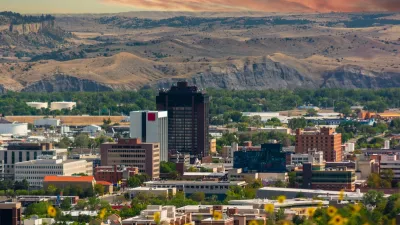A UCLA master's student and Don Shoup found that Santa Monica, CA's flexible parking requirements have led to significant fiscal and urban form benefits. A sample of parcels showed eight-times more sales tax revenue per sq. ft. than a control group.
It’s hard to imagine today, but Santa Monica’s commercial areas – now home to Silicon Beach, tourism and bustling retail – were sleepy, underperforming and shabby just a few decades ago. In an effort to revive its commercial heart in particular, the city approved millions in funding for municipal parking structures in the heart of downtown and implemented new, more flexible parking requirements.
The flexible parking requirements gave developers the ability to opt out of providing the required on-site parking by paying an annual fee of $1.50 per square foot of floor area added for which there was no parking provided. Further, it allowed for intensifying the use in a given building without having to provide the additional parking that would otherwise be required.
A study by UCLA urban planning graduate student Carter Rubin and Professor Don Shoup found that a group of parcels subject to the flexible requirements produces eight times more sales tax revenue per parcel square foot than a similar group of parcels just outside this flexible parking district. Further, significantly more street frontage on the flexible-requirement side has active uses, and much less area dedicated to dead parking space.
FULL STORY: How Flexible Parking Requirements Spur Economic Development: Lessons from Santa Monica

Planetizen Federal Action Tracker
A weekly monitor of how Trump’s orders and actions are impacting planners and planning in America.

Maui's Vacation Rental Debate Turns Ugly
Verbal attacks, misinformation campaigns and fistfights plague a high-stakes debate to convert thousands of vacation rentals into long-term housing.

Restaurant Patios Were a Pandemic Win — Why Were They so Hard to Keep?
Social distancing requirements and changes in travel patterns prompted cities to pilot new uses for street and sidewalk space. Then it got complicated.

In California Battle of Housing vs. Environment, Housing Just Won
A new state law significantly limits the power of CEQA, an environmental review law that served as a powerful tool for blocking new development.

Boulder Eliminates Parking Minimums Citywide
Officials estimate the cost of building a single underground parking space at up to $100,000.

Orange County, Florida Adopts Largest US “Sprawl Repair” Code
The ‘Orange Code’ seeks to rectify decades of sprawl-inducing, car-oriented development.
Urban Design for Planners 1: Software Tools
This six-course series explores essential urban design concepts using open source software and equips planners with the tools they need to participate fully in the urban design process.
Planning for Universal Design
Learn the tools for implementing Universal Design in planning regulations.
Heyer Gruel & Associates PA
JM Goldson LLC
Custer County Colorado
City of Camden Redevelopment Agency
City of Astoria
Transportation Research & Education Center (TREC) at Portland State University
Jefferson Parish Government
Camden Redevelopment Agency
City of Claremont





























